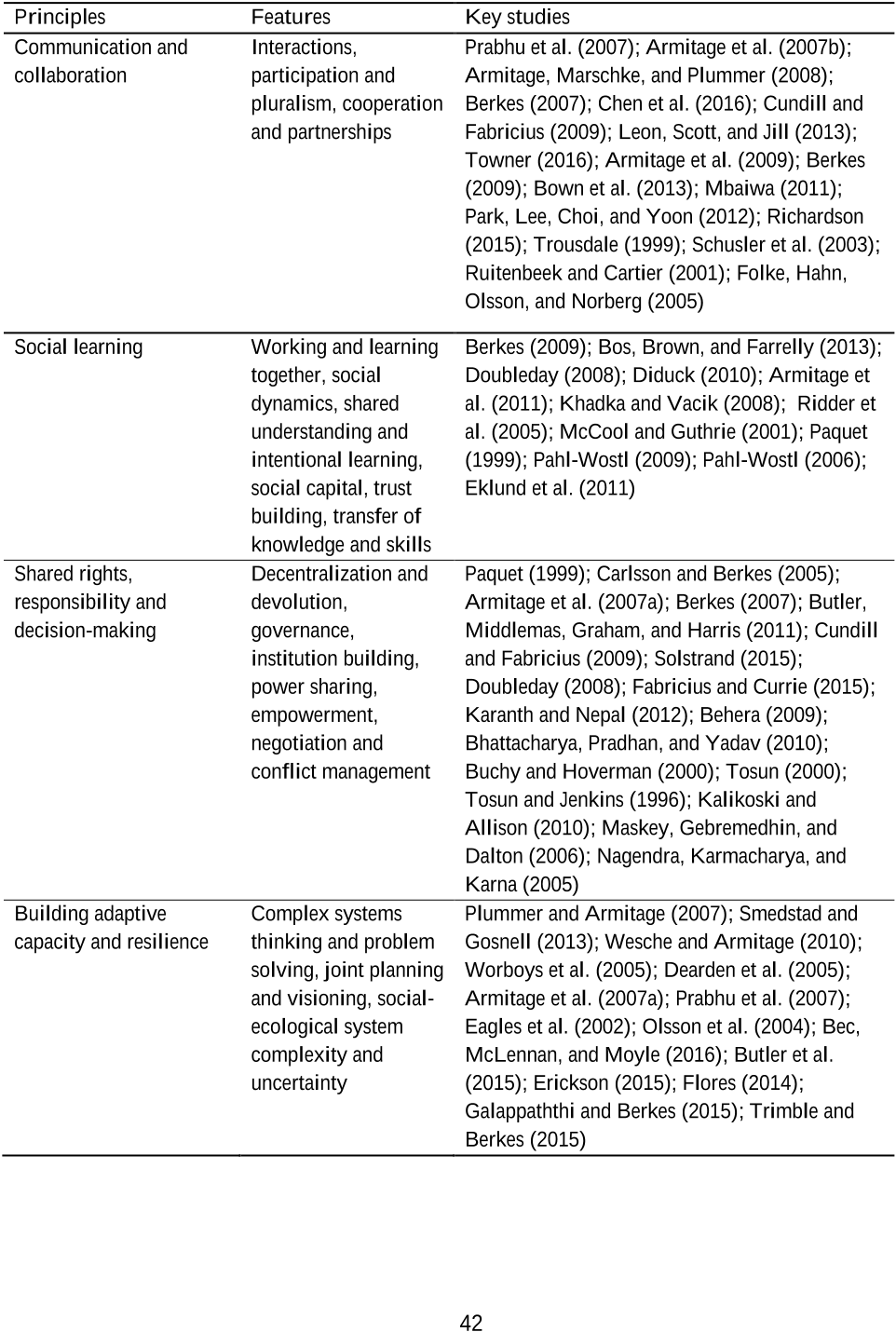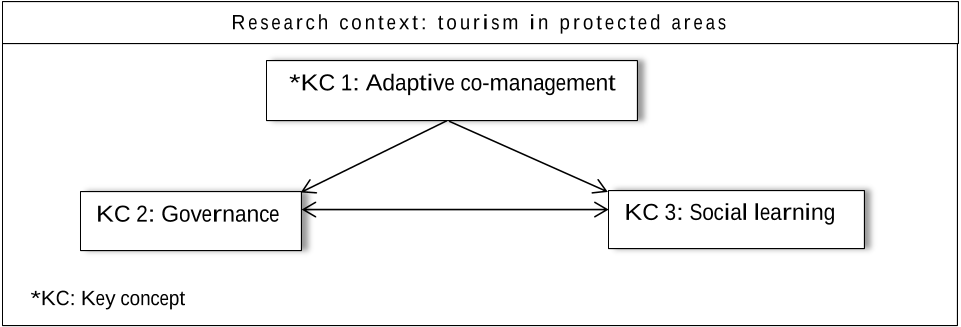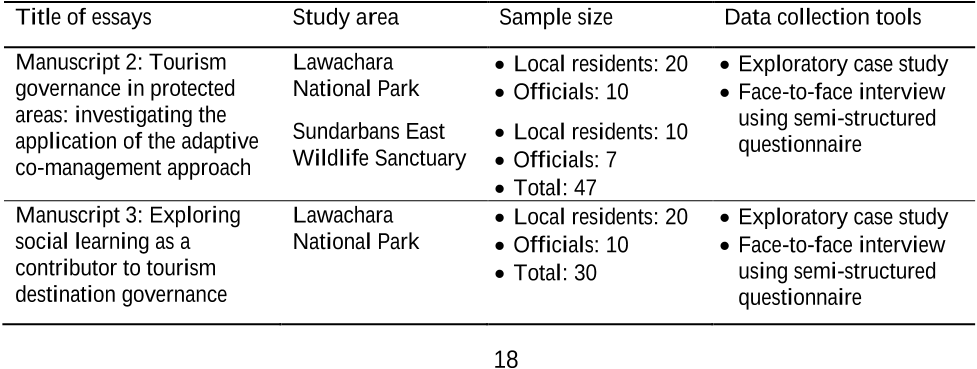
Adaptive co-management as an approach to tourism destination governance – a
case of protected areas in Bangladesh
Md. Wasiul Islam
B.Sc. (Hon’s), M.S., M.Sc.
A thesis submitted for the degree of Doctor of Philosophy at
The University of Queensland in 2017
School of Business

ii
Abstract
Tourism in protected areas can accelerate development opportunities by providing various direct and
indirect ecological, socio-economic and cultural benefits, particularly in developing countries
(Dudley, 2008; Newsome & Hassell, 2014; Tosun, 2000; WWF [World Wide Fund For Nature],
2014). However, developing countries, and their protected areas, are often characterised by poor
governance systems that impede the development of these locations as tourism destinations and
therefore affect those (poor) people living in and around these areas (Eklund, Arponen, Visconti, &
Cabeza, 2011; Parnini, 2006). Therefore, policy or institutional arrangements are required which
promote better governance systems and enable local people to obtain socio-economic and ecological
benefits from tourism activities (Figgis & Bushell, 2007). Consequently, a paradigm shift is occurring
within protected area planning and management with a transition from traditional top-down to
participatory bottom-up approaches to ensure the participation of local stakeholders in decision-
making, planning, implementation, monitoring and evaluation, and ultimately benefit-sharing
(Eagles, McCool, & Haynes, 2002; Niedziałkowski, Paavola, & Jędrzejewska, 2012). As such, these
institutional arrangements can promote better governance systems for local communities to improve
their living standards as well as facilitating effective protected area management planning systems
(Dearden, Bennett, & Johnston, 2005).
‘Adaptive co-management’ (ACM) is a dynamic process whereby institutional arrangements and
ecological knowledge are continually tested and revised through a process of ‘learning-by-doing’
(Armitage, Berkes, & Doubleday, 2007b). ACM has been suggested as a more inclusive alternate
approach to governance which can better facilitate the management and protection of natural
resources (Armitage, Berkes, Dale, Kocho-Schellenberg, & Patton, 2011; Plummer & Fitzgibbon,
2004a). ACM has also been advocated due to the fact that it can provide a means to empower local
stakeholders and enhance collaboration with other stakeholder groups. This is achieved through more
flexible systems that encompass complex cross-scale linkages (Olsson, Folke, & Berkes, 2004;
Wood, Butler, Sheaves, & Wani, 2013).
ACM has several attributes or principles. Social learning is one of the key principles and is based on
the creation of cooperative and collaborative frameworks that can facilitate iterative learning amongst
diverse groups of stakeholders (Ruitenbeek & Cartier, 2001; Schusler, Decker, & Pfeffer, 2003).
Social learning is particularly relevant for tourism development in protected areas as tourism is
multiple stakeholder activity requiring collaboration (Haddock-Fraser & Hampton, 2010; McCool,
2009). Both ACM and social learning have only recently been explored in tourism although the

iii
concepts have yet to be linked to tourism destination governance generally (Chen, Ku, & Chen, 2016;
Fennell, Plummer, & Marschke, 2008; Lai, Hsu, & Wearing, 2016; Pennington-Gray, Schroeder, &
Gale, 2014) or protected area governance specifically (Lai et al., 2016; Plummer & Fennell, 2009).
Addressing the identified research gaps, the overarching aim of this qualitative study is to investigate
the impacts of the ACM approach on tourism destination governance in the context of two protected
areas of Bangladesh; Lawachara National Park and Sundarbans East Wildlife Sanctuary.
This research follows the style of three interconnected manuscripts. Manuscript one presents a review
and synthesis of the ACM literature and in doing so identifies four inter-connected principles of the
ACM approach: communication and collaboration; social learning; shared rights, responsibility and
decision-making; and building adaptive capacity and resilience. A conceptual framework of tourism
destination governance that incorporates ACM principles, process, variables and outcomes is
developed. Manuscript two aims to empirically investigate the extent to which an ACM approach
was able to enhance the achievement of key governance principles such as participation, social
learning, accountability, transparency, power, and rule of law. Stakeholder interviews showed that
the ACM approach provided a congenial environment that facilitates iterative learning amongst
stakeholders, and for some, resulted in attitude and behaviour change towards protected area
conservation. Manuscript three is an exploratory study that sought to analyse how social learning is
embedded in the governance of a protected area tourism destination. The empirical findings show
that social learning allows for diverse stakeholder groups to interact together to create new
knowledge, develop awareness and empower local communities. The findings reinforce the
importance of social learning for tourism destination governance.
The overall theoretical and practical implications of this research are the application of ACM as an
approach that can enhance tourism destination governance. Enhanced governance systems are crucial
for contributing to sustainable tourism development objectives, as well as protected area conservation
and management.

iv
Declaration by author
This thesis is composed of my original work, and contains no material previously published or written
by another person except where due reference has been made in the text. I have clearly stated the
contribution by others to jointly-authored works that I have included in my thesis.
I have clearly stated the contribution of others to my thesis as a whole, including statistical assistance,
survey design, data analysis, significant technical procedures, professional editorial advice, financial
support and any other original research work used or reported in my thesis. The content of my thesis
is the result of work I have carried out since the commencement of my higher degree by research
candidature and does not include a substantial part of work that has been submitted to qualify for the
award of any other degree or diploma in any university or other tertiary institution. I have clearly
stated which parts of my thesis, if any, have been submitted to qualify for another award.
I acknowledge that an electronic copy of my thesis must be lodged with the University Library and,
subject to the policy and procedures of The University of Queensland, the thesis be made available
for research and study in accordance with the Copyright Act 1968 unless a period of embargo has
been approved by the Dean of the Graduate School.
I acknowledge that copyright of all material contained in my thesis resides with the copyright
holder(s) of that material. Where appropriate I have obtained copyright permission from the copyright
holder to reproduce material in this thesis and have sought permission from co-authors for any jointly
authored works included in the thesis.

v
Publications during candidature
Peer-reviewed journal paper:
Islam, M. W., Ruhanen, L., & Ritchie, B. W. (2017). Adaptive co-management: A novel approach to
tourism destination governance? Journal of Hospitality and Tourism Management, DOI:
10.1016/j.jhtm.2017.10.009
Islam, M. W., Ruhanen, L., & Ritchie, B. W. (2018). Exploring social learning as a contributor to
tourism destination governance. Tourism Recreation Research,
DOI:10.1080/02508281.2017.1421294
Peer-reviewed conference working papers:
Islam, M. W., Ruhanen, L., & Ritchie, B. W. (2016). Exploring social learning in the protected areas
of Bangladesh. Proceedings of the 26
th
Annual Council for Australasian Tourism and
Hospitality Education (CAUTHE) Conference, 9-11 Feb 2016, Blue Mountains International
Hotel Management School, Sydney, NSW, Australia, pp. 1204-1210.
Islam, M. W. & Ruhanen, L. (2015). Governance for tourism: Investigating the application of
adaptive co-management – a conceptual paper. Proceedings of the 25
th
Annual Council for
Australasian Tourism and Hospitality Education (CAUTHE) Conference, 2-5 Feb 2015,
Southern Cross University, Gold Coast, QLD, Australia, pp. 547-550.
Peer-reviewed conference abstracts/pitches:
Islam, M. W. (2015). Wildlife conservation through nature-based tourism in Lawachara National
Park: A realism or idealism? Presented at the Updating Species Red List of Bangladesh
Conference held on 14 June 2015 at CSS AVA Centre, Khulna, Bangladesh. Jointly organised
by International Union for Conservation of Nature (IUCN) and Khulna University, pp. 71-75.
Islam, M. W., Ruhanen, L., & Ritchie, B. W. (2016). From local community harassment to
motivation: Adaptive co-management as an innovative tourism destination governance
approach. Presented at the 1
st
University of Queensland Bangladesh Association (UQBDA)
Conference on Taking Bangladesh Forward held on 27 Sept 2016 at University of Queensland,
Australia, pp. 20.
















